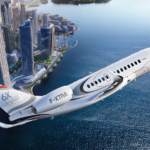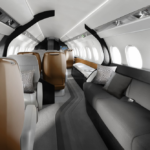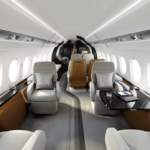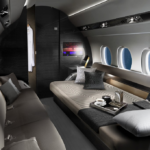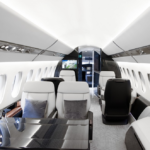Despite Corona, Dassault wants to deliver its new Falcon 6X private jet to customers on time, starting from 2022. At Bordeaux-Mérignac, work is therefore in full swing to complete the test aircraft. Deployment is scheduled for December 8.
Fighter plane DNA
With the Falcon 6X, Dassault is once again demonstrating its technological advantages, which also result from the development of high-tech combat aircraft. Speed and quality are needed more than ever, as the 6X replaces the Falcon 5X program, interrupted by Safran in December 2017 after insurmountable problems with the Silvercrest engine. The 5X should be delivered from 2020. The Falcon 6X offers a very spacious cabin and can perform flights like Los Angeles – London at Mach 0.85.
The best in the debacle
To make the most of the debacle, Dassault further optimized the Falcon 6X with a longer fuselage and range, touting it as “the most spacious, advanced and versatile twin-engine aircraft in aviation in the world.” business”. It offers the largest cabin section in the industry (1.98 m high and 2.58 m wide), and thanks to its range of 10,185 kilometers, it manages links such as Paris-Tokyo or Los Angeles-Moscow. For comparison, a Gulfstream G650 has a cabin whose height is limited to 1.90 m. It remains to be seen whether this formula will appeal to potential customers. Dassault is confident, especially since many 5X customers have rewritten their contracts for the new model despite the late delivery.
Falcon 6X, a top priority
“Getting the Falcon 6X to market on time is a top priority for the company,” said Eric Trappier, President and CEO of Dassault Aviation. This is why, faced with difficult circumstances since the spread of the coronavirus, the French manufacturer has “carefully and ingeniously adapted its procedures to the new hygiene instructions” in order to make the first plane take off at the beginning of next year. “Our suppliers have also gone to great lengths to support us,” said Trappier.
“Power-on” in summer
According to Dassault, it was possible to “power up” the first machine and start checking systems in early July. Final assembly began at the start of the year after the arrival of the large components at the Mérignac plant. The wings came from Martignas, where they were assembled using the most modern precision robotics. The cladding panels up to ten meters long with integrated stiffeners were supplied by the Seclin plant near Lille. It has milling machines specially developed for Dassault, which allow rapid and efficient production. These factories also manufacture parts such as the massive ribs of the wing’s center section, which serve as practically the basis for assembling the three-part fuselage. This work takes place in the Biarritz plant before the completion of the equipment with all the cables and systems in Argonay.
Soil tests
Meanwhile, testing of the Pratt & Whitney PW812D engine is also well underway. Earlier this year, a first flight test campaign on a Pratt & Whitney Canada Boeing 747SP was completed and a second round of flight tests took place this summer. By early July, the PW812D had spent more than 200 hours in the air and more than 1,600 hours on the ground. It also passed initial approval tests, including behavior in collision with birds and when vacuuming chunks of ice. The blade-off test was also performed to prove that the fan blades could be safely held in the nacelle built by Collins Aerospace in an emergency.
Dassault and its suppliers work together on a central model that provides detailed information.
Virtual board phase
According to Dassault, a key factor in meeting the very tight Falcon 6X development schedule is the “physical and virtual platform development process”. After the program was launched in 2018, Dassault engineers and 20 main suppliers first worked together in Saint-Cloud. They focused on the harmonization of interfaces between the main aeronautical systems. Since the start of the so-called “virtual plateau phase” in fall 2018, everyone involved has been working from home – sharing a central digital model of the aircraft in real time. Advanced virtual reality tools allow you to examine the placement of systems and components from perspectives not available in previous programs.
Dimensions of the cabin
| Height | 78.00 in / 1.98 m |
| Width | 102 in / 2.58 m |
| Length (excluding cockpit and luggage compartment) | 40 ft 4 in / 12.30 m |
| Volume (excluding cockpit and luggage compartment) | 1,845 ft3 / 52.2 m3 |
| Luggage compartment volume | 155 ft3 / 4.4 m3 |
Performances
| Travel distance (8 passengers, 3 crew, NBAA IFR, ISA reserves, full fuel) | 5,500 nm / 10,186 km at Mach .80 – 5,100 nm / 9,445 km at Mach .85 |
| MMO (Mach Maxi Operational) | Mach .90 |
| Landing distance (SL) | 2,480 ft / 760 m |
| Certified ceiling | 51,000 ft / 15,545 m |
| Equivalent track length (balanced) (MTOW; SL; ISA) | 5,480 ft / 1,670 m |
| Approach speed (Vref) (8 passengers, 3 crew, NBAA IFR reserves) | 109 kias / 202 km / h |


